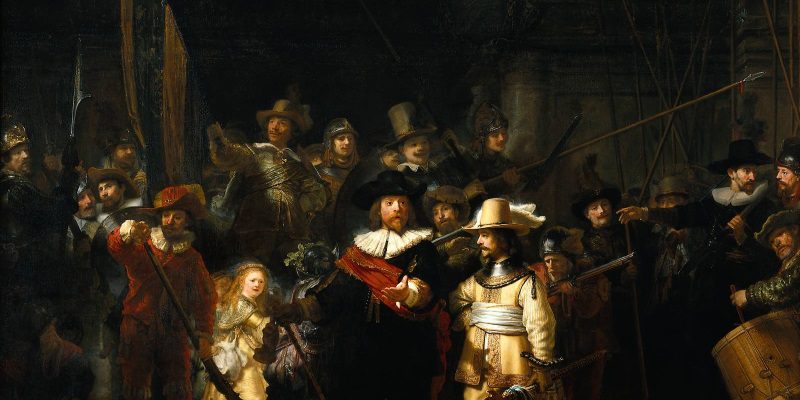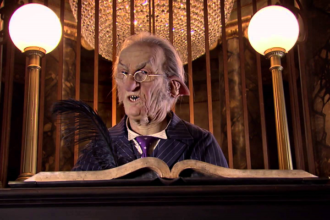A Fire Hose of Homebrewed Content

D&D 5th Edition is a ridiculously fun environment for homebrewed design. It offers an incredible sense of adaptability, with just enough structure to make it clear how things fit together. The blogsophere and various message boards have frickin’ exploded with great free content. Accordingly, the following is a roundup of subclasses, spells, magic items, and so on from my personal blog, Harbinger of Doom, as well as things from my friend Stands-in-Fire’s blog.
(Perhaps you are wondering about the image, which is Militia Company of District II under the Command of Captain Frans Banninck Cocq, by Rembrandt, otherwise known as The Night Watch. I really like it, and it portrays a group of people who are ready to do some serious adventuring.)
Backgrounds
- The Enforcer is for members of the city watch, investigators, and criminal legbreakers.
Races
- Planar Races: Aasimar, Bauriar, Bladeling, Genasi, Ratatosk (Stands in Fire)
- Four new races, one of which is a revised version of the Human.
Subclasses
- Barbarian
- The Path of the Demon-scarred is for barbarians who have, willingly or unwillingly, taken on aspects of demons.
- The Path of the Raider is for barbarians who use cunning to take what others possess. (Stands in Fire)
- Bard
- The College of Heraldry is for bards who have become the agents and public faces of Otherworldly Patrons. (Stands in Fire)
- Cleric
- The Exorcism Domain is for clerics who focus on breaking fiendish or ghostly influences.
- Druid
- The Circle of Stars is for druids who protect the world from cosmic horror… or invoke cosmic horror themselves. (Stands in Fire)
- Paladin
- The Oath to the Dead God is for paladins whose gods drift upon the Astral Sea. It is especially friendly to paladins of a sinister bent. (Stands in Fire)
- Ranger
- The Death Watcher ranger protects the boundary between life and death, and uses of the souls of the dead to do so. (Stands in Fire)
- Rogue
- The Brigand is an adaptation of 4e’s Brutal rogue build that uses Strength and spending sneak attack dice as a tactical currency. (Stands in Fire)
- The Divine Trickster is to divine magic what the arcane trickster is to arcane magic, of course.
- The Investigator is for rogues who investigate crimes and bring down other criminals.
- The Mastermind is for rogues who lead teams and plot daring heists.
- Sorcerer
- The Royal Sorcerer bloodline is for sorcerers who derive their power from the divine right of kings, even if they do not wear the crown themselves.
- Warlock
- The Malediction Pact and the Death Patron are for warlocks who just don’t get enough creepy out of the class as it is.
Revised Classes
- The Revised Warlock is Stands-in-Fire’s take on addressing the class’s shortcomings. (Stands-in-Fire)
Feats
Spells and Invocations
- The Atrous Spike: a collection of four new spells for sorcerers and wizards. I created these pretty early in the 5e public playtest cycle, so they don’t completely conform to the published rules, but the idea behind them is still pretty cool.
- Magical Traps: a collection of five new spells for druids and rangers that create magical traps.
- Eight new Warlock Invocations
- Five new Cleric Spells: of special note, two new damage-dealing cantrips, so they have more at-will options than sacred flame.
Magic Items
- Arrow-Caching Shield (Stands in Fire)
- Bag of Bones (Stands in Fire)
- Gem of Searing (Stands in Fire)
- Hat of Disgust (Stands in Fire)
- Lyre of the Last Dance (Stands in Fire)
- Saddle of the Cadaver (Stands in Fire)
- Four-item collection: the Bone Mask of the Naga, the Horn of the Long Night, the Blade of Deep Waters, and Vardevain’s Rod
- Four Magical Flintlock Weapons: these were created from a public-playtest draft of the magic item rules, so some things may have changed
- Five-item collection: the Vial of the Black Moon, the Rod of Reproof, the Chain of Teeth, the Eye of Naula, and Ost-ormë, the Wand of Weeping.
- Training as Treasure, or: when is an item not an item?
Monsters
- New fey creatures: glutton-fey, goblin-fey, leech-fey, and poison-fey
- Myrkridia, from the excellent Myth video games
House Rules
- Giving Ground is a new reaction that all characters can use to reduce incoming melee damage by sacrificing position.
- Investigation Encounters are a way to make sure that one failed roll doesn’t cause a whole investigation storyline to hit a dead end.
- Magic Item Economy offers tweaked rules for buying, selling, and commissioning magic items, for settings where that is appropriate.



